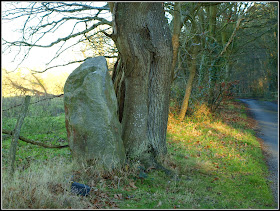I have written already about the scenery and the plants and fungi, so how about mosses and lichens?
I came off the canal towpath at Stacey's Bridge: (built 1792; re-built 1975)
The bridge probably used to carry a road, but these days there is only a muddy footpath between the two crumbling walls of mellow brick:
The tops of the walls are covered in moss:
Close inspection of the wall reveals a multitude of different mosses, lichens and fungi:
After crossing the bridge and beginning to head homewards along the leafy lane which runs parallel to the canal, I noticed more and more mosses. In fact, almost every surface was covered in some sort of growth.
 |
| This stone has evidently not been doing much rolling. |
 |
| Does this remind you of a font, in a church? |
There were several big upright stones like this. I suppose they are ancient boundary-markers of some sort. I can't believe anyone would have put them there just for the fun of it. Each one must weigh at least a ton!
This is a close-up of the surface of one of those stones - deeply pitted. It looks rather like a piece of wood that had been repeatedly attacked by a Woodpecker!
This is a deep hollow in the "crook" of a tree. It collects rainwater and is therefore more or less permanently moist, so it supports its own patch of moss.
I peered inside this hole in the trunk of another big old tree.
There was a miniature lake inside...
This is a close-up of moss growing on a tree. It looks to me just like bushes on a rocky mountainside.
This moss is growing on a log in the car-park where I left my car. You can tell it was cold that day - there was still thick frost on the log at half-past three, despite the sunny afternoon.
Finally for today, I want to publish another photo of a fungus I saw last weekend, for which I now have a positive identification:
This is "Tremella Mesenterica" aka "Witches Butter" and "Yellow Brain Fungus". Thanks to @mouseinthewood on Twitter, for the ID. If you are interested in fungi or foraging in general, it's worth following him.




















What's next lichen?
ReplyDeleteThat moss does look like bushes on a mountainside. You wouldn't really know the scale if you didn't know it was moss.
ReplyDeleteGood growth of lichens and mosses is a sign of clean air and is used as one of the ecological measures of air quality. The increase in growth has been helped by the reduction in heavy industrial manufacturing (and improved industrial processes) in many parts of the country. I know we need industry, but it is nice to see a positive improvement in the environment.
ReplyDeleteI love those moss covered walls. Pretty.
ReplyDelete